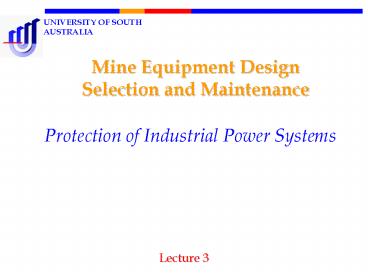Protection of Industrial Power Systems - PowerPoint PPT Presentation
1 / 16
Title:
Protection of Industrial Power Systems
Description:
UNIVERSITY OF SOUTH AUSTRALIA. Protection of Industrial Power Systems. Lecture 3 ... Must be discriminative - only faulty circuit is isolated and other circuits ... – PowerPoint PPT presentation
Number of Views:267
Avg rating:3.0/5.0
Title: Protection of Industrial Power Systems
1
Protection of Industrial Power Systems
Mine Equipment Design Selection and Maintenance
- Lecture 3
2
Faults
- Any abnormal state of the system
- Open circuit faults
- less common
- of less concern
- often followed by a short-circuit fault
- but may be a hazard for personnel
- Short-circuit faults
- due to short circuits
- more common and more severe consequences
- Overload currents
- Overvoltage ( voltage surges and transients) due
to - lightning strikes
- switching
3
Dangers From Short Circuit (S/C) Faults
- If allowed to persist for an extended period S/C
faults may cause - Reduced stability of the power system
- Damage to the equipment in the vicinity of the
fault - Explosions in equipment containing insulating oil
followed by fire, injuries to personnel and
damage to other equipment - Cascading effect - disruption in a large power
system service area due to successive action of
protective devices
4
(No Transcript)
5
Role of System Protection
- to detect faults
- to selectively isolate faulted parts of the
system - to permit short clearance time to limit the fault
power - if a protection device fails, the upstream
protection device must provide the
protection - selectivity(discrimination)
- a fault is detected by a number of protection
devices, but only the protection device closest
(and above) to the fault location is triggered
6
Requirements of Protection of Wiring
- Must carry its rated current continuously without
overheating or deterioration - Small overloads of short duration should not
activate them - Small overloads of duration long enough to cause
overheating should activate them - protection must open the circuit before the
damage is caused by fault currents - Must be discriminative - only faulty circuit is
isolated and other circuits remain unaffected and
operative
7
Protective Devices
- Most commonly used are
- Fuses
- Circuit Breakers
- Relays
- Reclosers
- Combination of those
- They have different switching(tripping or
pre-arcing) characteristic - is pre-arcing time vs. current - the elapsed
time between the commencement of the current
(large enough to melt the fuse or open circuit
breaker contacts) and the instant of melting or
opening.
8
(No Transcript)
9
Reactors at Mining Sites (left) for Filtering
electrical noise (disturbances) produced by heavy
machinery. HV transformer with bushings (right).
10
Grading of Series-Connected Fuses
- Absolute discrimination (selectivity) is achieved
if the ratio of the current ratings for these two
fuses is 1.6. (Fig.1.3/18)
11
Grading of Circuit Breakers
12
Grading of Circuit Breakers
13
Typical Protection System
- Transducer (sensor)
- detects the increase of current and drop of
voltage due to short circuit in the system - CT (current transformer) or VT(voltage
transformer) - Relay
- read the signal from transducer
- energize the tripping circuit of the circuit
breaker - Circuit Breaker
- open their contacts to disconnect the section
with the fault
14
Circuit Breaker (left), Current Transformer
(middle), Voltage Transformer (right)
15
Overcurrent Protection Current Transformers
Circuit breakers
16
- Rated Switching Capacity
- Is the maximum value of the short-circuit current
that the protection device can clear correctly. - Back-up protection
- in case of fault larger than rated switching
capacity the back-up must activate the upstream
(above) protection device - Zone protection
- protects sections of power system distribution
- zones overlap
- Motor Protection
- HRC fuses,
- fuzecontactorthermal overload relay
- switch gear assemblies with thermistor protection
devices (for motors operating in tough
conditions) - motors with thermally critical rotor must have
overload relay.

